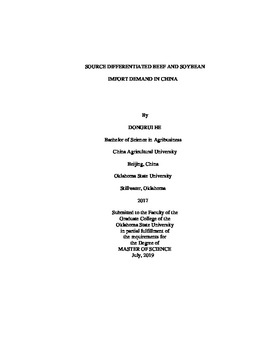| dc.contributor.advisor | Henneberry, Shida Rastegari | |
| dc.contributor.author | He, Dongrui | |
| dc.date.accessioned | 2020-01-30T19:46:38Z | |
| dc.date.available | 2020-01-30T19:46:38Z | |
| dc.date.issued | 2019-07 | |
| dc.identifier.uri | https://hdl.handle.net/11244/323396 | |
| dc.description.abstract | Firstly, this study used a Source Differentiated Linear Approximated Almost Ideal Demand System (LA/AIDS) model to estimate beef import demand in China. The conditional price and expenditure elasticities of demand are estimated for each exporting country. The model also estimated how diseases outbreaks and seasonality affect the beef import demand in China. Separability, normality, and endogeneity are tested to validate the model. The empirical results showed that Brazilian beef, Uruguayan beef, and Australian beef are substitutes to each other. Among the exporters, Brazilian beef has the weakest position in China's beef import market due to the highest price elasticity. Bovine Spongiform Encephalopathy (BSE) has a negative influence on imported beef demand from Brazil and Uruguay but it positively affects Australian beef. Seasonal dummies do have an impact on beef import demand. | |
| dc.description.abstract | Secondly, a differential production approach is used to address China's soybean import from different sources. By clarifying two-stage budgeting, a derived demand model is applied for the multiproduct firm. From the results, the U.S. is competing with Brazil and Argentina as well as the rest of the world (ROW) in exporting soybeans. Brazil and Argentina are complementary to China's soybean imports. Seasonal factors have a great impact on China's soybean imports. The soybean exports increases immediately after harvest season for each soybean source. Seasonality is shown to have a reverse effect on the soybean import from the U.S. and South American countries since they are located in different hemispheres. | |
| dc.format | application/pdf | |
| dc.language | en_US | |
| dc.rights | Copyright is held by the author who has granted the Oklahoma State University Library the non-exclusive right to share this material in its institutional repository. Contact Digital Library Services at lib-dls@okstate.edu or 405-744-9161 for the permission policy on the use, reproduction or distribution of this material. | |
| dc.title | Source Differentiated Beef and Soybean Import Demand in China | |
| dc.contributor.committeeMember | Brorsen, B. Wade | |
| dc.contributor.committeeMember | Molnar, R. Adam | |
| dc.contributor.committeeMember | Zheng, Zhihao | |
| osu.filename | He_okstate_0664M_16447.pdf | |
| osu.accesstype | Open Access | |
| dc.type.genre | Thesis | |
| dc.type.material | Text | |
| dc.subject.keywords | demand system | |
| dc.subject.keywords | elasticities | |
| dc.subject.keywords | imports | |
| thesis.degree.discipline | Agricultural Economics | |
| thesis.degree.grantor | Oklahoma State University | |
